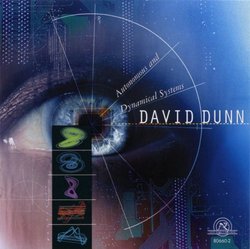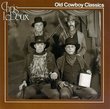| All Artists: David Dunn Title: David Dunn: Autonomous and Dynamical Systems Members Wishing: 0 Total Copies: 0 Label: New World Records Original Release Date: 1/1/2007 Re-Release Date: 5/1/2007 Genre: Classical Styles: Chamber Music, Historical Periods, Classical (c.1770-1830) Number of Discs: 1 SwapaCD Credits: 1 UPC: 093228066026 |
Search - David Dunn :: David Dunn: Autonomous and Dynamical Systems
 | David Dunn David Dunn: Autonomous and Dynamical Systems Genre: Classical
A relentless explorer, composer, performer and theorist, David Dunn (born 1953) uses electro-acoustic resources, voice, non-human living systems, as well as traditional instruments. A creator of text-sound compositions, en... more » |
Larger Image |
CD Details
Synopsis
Product Description
A relentless explorer, composer, performer and theorist, David Dunn (born 1953) uses electro-acoustic resources, voice, non-human living systems, as well as traditional instruments. A creator of text-sound compositions, environmental installations, works for radio and video, he has also written and published extensively. Underlying all his work is a common regard for music as a communicative source with a living world. Growing up in San Diego in the sixties and seventies, he encountered people like Harry Partch and Kenneth Gaburo. He worked with Partch for about five years, and continued to be in his ensemble for a decade after his death. His association with Gaburo was even longer, and lasted until Gaburo's death in the early 1990s. This CD features four new compositions, all for electronic sound makers of one sort or another, and all four reveal his innate musicality. These are works that live between the arts and the sciences, coming from his lifelong involvement with interdisciplinary ideas. Lorenz is a collaboration between Dunn and chaos scientist James Crutchfield. In this piece, Crutchfield's program for exploring chaos equations, MODE (Multiple Ordinary Differential Equations), is linked through an interface program called OSC into a sound synthesis program. The sound synthesis program feeds information back through OSC into MODE, so the whole thing is not only a use of chaos to control sound-it's a feedback loop itself, embodying the principles of chaos not only in its mathematics, but also in its very structure. Another aspect of Dunn's work has been setting up interactive systems within nature, whereby humans, machines, and the environment interact with each other. In the mid-1980s, as the technology became smaller, and cheaper, he began a series of works where he tried to set up interactive systems in which the environment could interact with itself. Autonomous Systems: Red Rocks is the latest in this series of works, and possibly the most elegant
Similar CDs
| Chris Ledoux Old Cowboy Classics Genres: Country, Pop Label: Capitol | |

 Track Listings (4) - Disc #1
Track Listings (4) - Disc #1